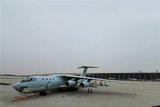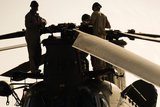Transforming flight operations through next-gen connectivity (Studio)
The highest standards of connectivity are crucial for aircraft in today’s military environment – and can play a key role during any crisis.
That’s according to experts at Honeywell, a major player in military aerospace connectivity solutions from both a hardware and a data analytics perspective.
On the hardware side, the company is a long-time provider of satellite communications (SATCOM) for both fixed and rotary-wing aircraft. This technology has significantly advanced over the years, says Tim Roberts, Director of Connected Defense Solutions at Honeywell Aerospace.
Roberts compares the progress in SATCOM to the evolution of mobile phones, which were first designed to simply make a call from one place to another. Similarly, SATCOM systems on-board aircraft were originally intended to provide very simple communications—to ensure that air traffic control (ATC) could contact a crew, if for example the platform needed to change heading or airspeed or if there was an alteration to the flight plan.
However, much like the journey to the smartphone, connectivity solutions have undergone significant development: as phones have gone from 2G to 5G, so SATCOM has transitioned from L-band to Ka- and from large global coverage areas to High Through-Put SATCOM (HTS) spot beam coverage, greatly increasing available data rates.
For full size version, click here
This means operators now have access to much greater bandwidth on and off the platforms and improved applications utilizing that bandwidth, opening the door for vastly improved situational awareness.
‘Not only are we able to continue to help the aircraft fly safely, by maintaining contact with ATC, but we’re also able to improve the mission side of the aircraft,’ Roberts explains.
To illustrate the benefits of real-time situational awareness, he uses the example of an aircraft that departs for a mission or target that is a one-hour flight away. In that hour, a great deal can happen. If the mission commanders at HQ have an improved ability to transmit information – or any changes or developments – to the crew, then the aircraft’s mission can be modified as necessary, ‘creating a much more effective mission stance’.
From the other perspective, the improved bandwidth means the platform can send more data – for example, information gathered from electro-optical/infrared (EO/IR) sensors – back to headquarters.
Additionally, Roberts points to reductions in size, weight and power (SWAP) demands, which means that SATCOM solutions – and other sensors – can now be used on smaller platforms like unmanned aerial vehicles (UAVs), adding to improved, overall situational awareness in the area of operations.
All of this provides a far richer data environment for operators, boosting situational awareness in a dynamic, quickly evolving crisis environment.
Roberts points to the use of military aircraft in a humanitarian relief or natural disaster scenario, where they can now transmit far greater volumes of data to headquarters and other stakeholders. This data can then be centralised and synthesised with other information to improve or adapt the mission as necessary.
‘All of that can be done beyond line-of-sight, in real time – as the aircraft is flying, that information is communicated via our SATCOM solutions,’ Roberts explains.
Honeywell doesn’t just provide the hardware that underpins connectivity; it also offers a portfolio of services that makes the best use of that data when it arrives.
This is through its Honeywell Forge portfolio (previously known as GoDirect), which provides data analytics that can be used in a range of areas, driving advanced real-time analysis and allowing operators to monitor the aircraft’s condition and other parameters.
Wesley Cook, Business Development Director of Engineering Services, highlights the role of SATCOM systems in helicopters.
As an example of the benefits of connectivity that such solutions can provide, Cook says the high-data rate connectivity could be coupled with a helicopter’s health and usage monitoring system (HUMS), supporting everything from intelligence, surveillance and reconnaissance (ISR) to medical evacuation.
Because the Honeywell Forge portfolio sits within the company’s Connected Enterprise vertical, where Honeywell has a high level of expertise in software development, custom applications can be developed for an array of use cases, Cook notes.
While connectivity is crucial for situational awareness today, there are also risks, notably the potential for cybersecurity threats. This is a key focus for Honeywell, which works closely with its SATCOM customers to engineer the appropriate data back haul to the customer’s required point of presence with the appropriate encryption hardware, among a range of other cyber-hardening services and solutions.
To find out more please click here
More from Impact of COVID-19 Special Report
-
![UK resumes air defence infrastructure upgrade after COVID-related hiatus]()
UK resumes air defence infrastructure upgrade after COVID-related hiatus
The RAF plans by the end of the year to complete upgrade work to the physical infrastructure supporting a ground-based air surveillance radar in northeast England. …
-
![DoD confirms five Defense Production Act Title 3 COVID-19 actions]()
DoD confirms five Defense Production Act Title 3 COVID-19 actions
The US DoD confirmed $135 million in Defense Production Act Title 3 COVID-19 actions aimed at maintaining defence critical workforce capabilities in body armour, aircraft …
-
![PLA delivers medical supplies to armed forces of 20 countries]()
PLA delivers medical supplies to armed forces of 20 countries
At the request of China’s Central Military Commission (CMC), the People’s Liberation Army Air Force has delivered medical supplies including personal protective equipment and surgical …
-
![IAI develops COVID-19 medical condition modelling]()
IAI develops COVID-19 medical condition modelling
Israel Aerospace Industries (IAI) reported on 8 June that it has developed a model which predicts the progression of the medical condition of COVID-19 patients, …
-
![Being agile, flexible and timely in a time of crisis (Studio)]()
Being agile, flexible and timely in a time of crisis (Studio)
Military aerospace maintenance, repair and overhaul (MRO) services must adapt to crises, even those as severe and unexpected as the coronavirus (COVID-19) pandemic. For Honeywell, …
-
![COVID-19 prompts RCAF to enhance medevac capabilities]()
COVID-19 prompts RCAF to enhance medevac capabilities
The Canadian Department of National Defence (DND) is procuring a new isolation system to facilitate the transport of up to four highly infectious patients on …


























